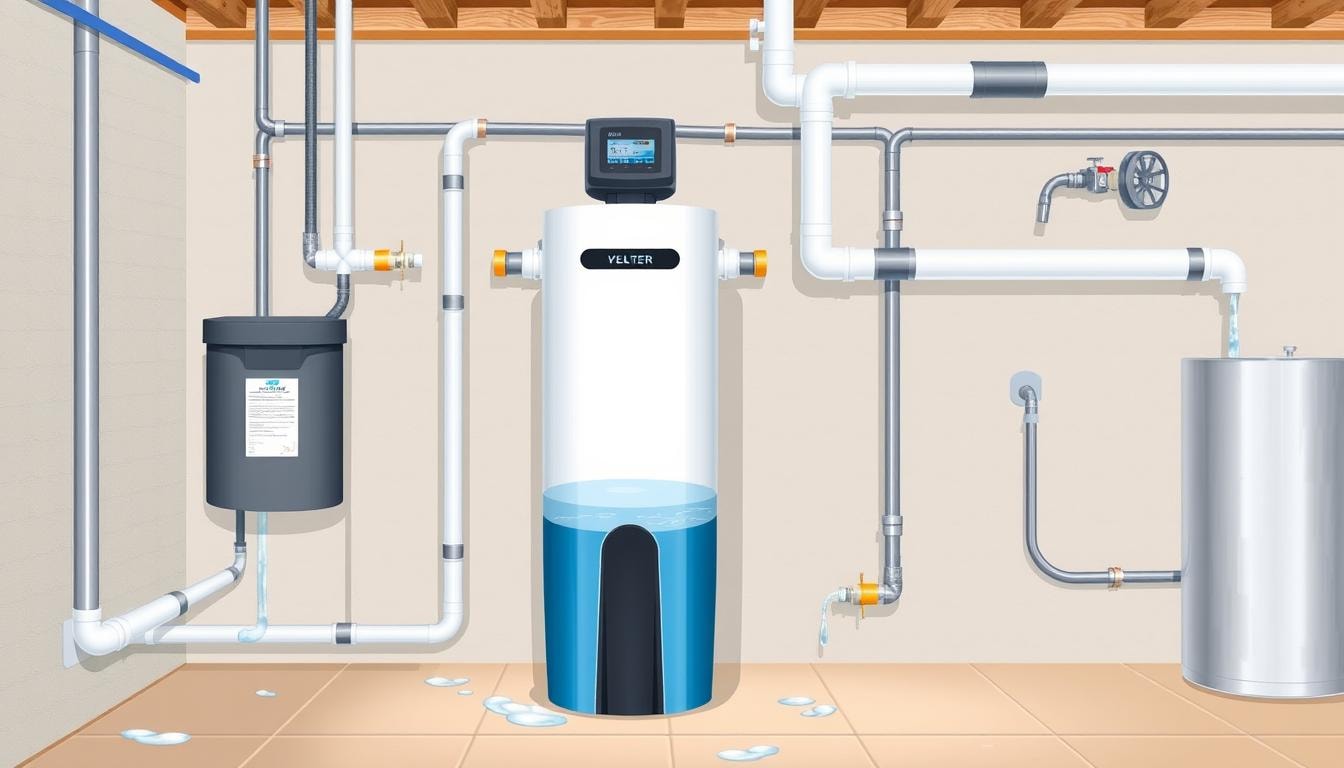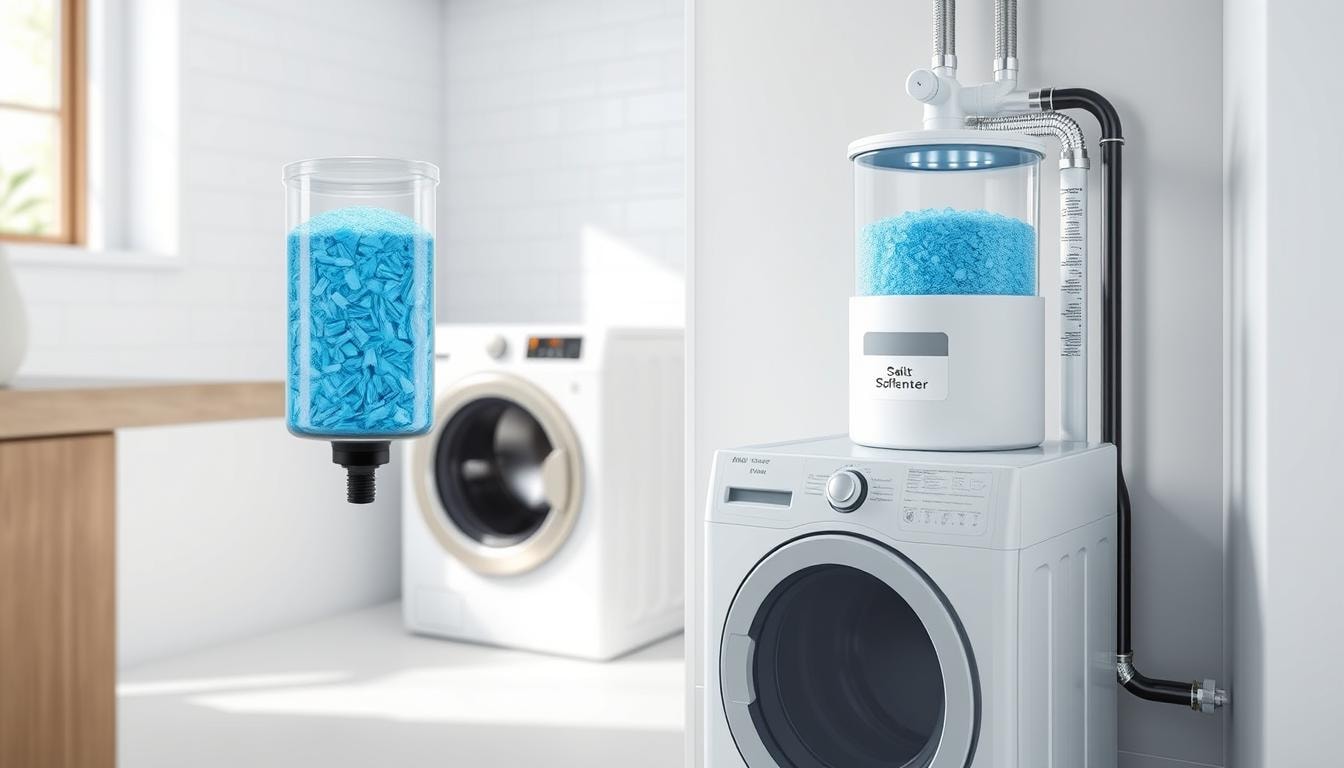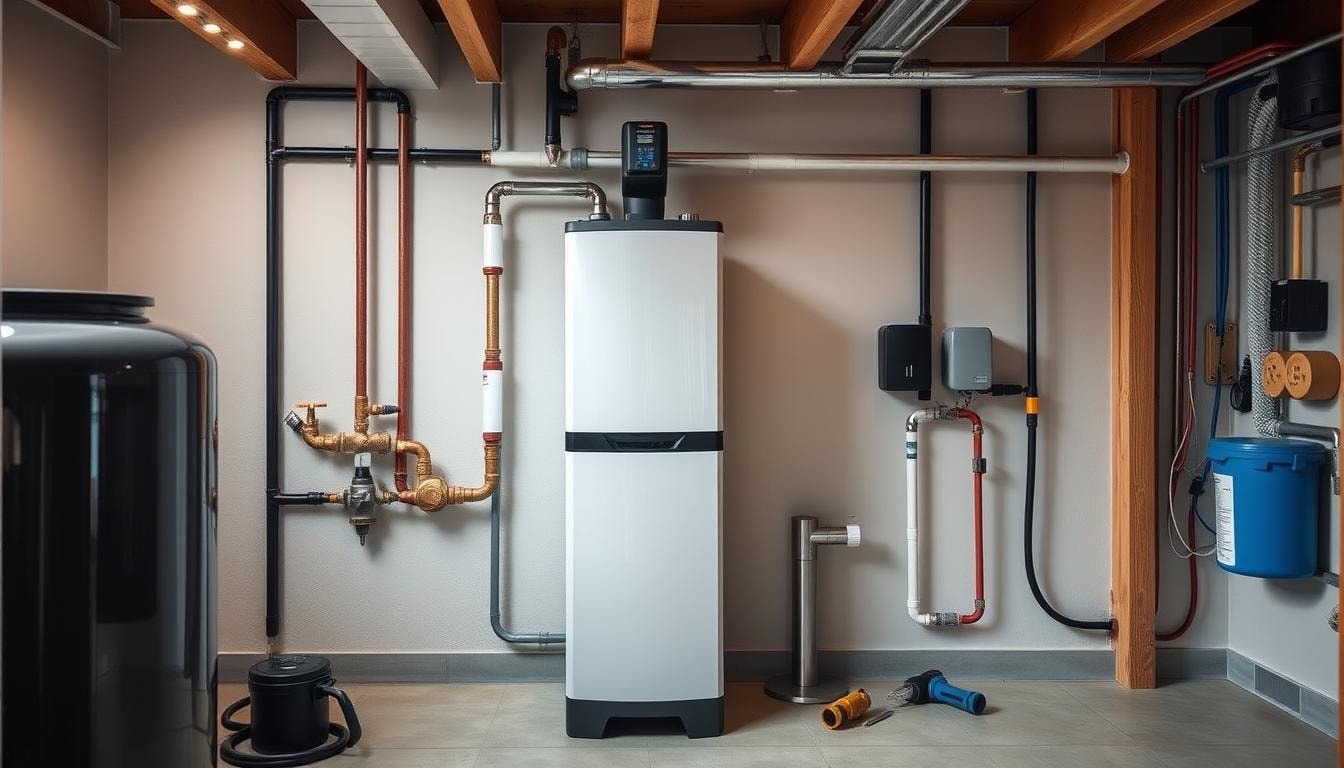Water Softener Installation Near You
Can’t find what you are looking for?
How It Works
-
Answer a few questions about your home project.
-
Within seconds, get matched with top-rated local pros.
-
Compare quotes and choose the best pro for the job.
Water Softener Installation In Your Area
Water Softener Installation: Your Guide to Soft Water
Meta Description: Learn how to install a water softener with our comprehensive guide. Improve your home’s water quality and extend appliance life with proper Water Softener Installation.

Installing a water softener can be a manageable DIY project. It’s cheaper than hiring a pro if you know basic plumbing. The cost depends on the unit’s grain capacity and your household size.
For 1-4 people, a 30,000-grain unit is usually sufficient. Larger families of 5-6 need at least 40,000 grains. Convenient pre-plumbing near the equipment can simplify installation and reduce costs.
To find the ideal water softener, plan your budget carefully. Consider all factors involved in the installation process. This will help you choose the right unit for your needs.
Key Takeaways
- DIY water softener installation can save money compared to hiring a professional.
- Household size and water usage determine the required grain capacity of the water softener.
- Convenient pre-plumbing can simplify the installation process and reduce costs.
- Understanding the factors involved is crucial to selecting the right water softener for your home.
- Proper planning and budgeting can help make the water softener installation a successful project.
Understanding Water Softeners
What is a Water Softener?
A water softener removes heavy minerals like calcium, iron, and magnesium from your water supply. It reduces water hardness by stopping these minerals from binding or flowing through. This device offers many benefits to homeowners.
Benefits of Installing a Water Softener
- Softened water can save money by extending the life of water-based appliances and plumbing systems. It prevents mineral buildup and scale formation.
- Softened water gives you cleaner hair, softer skin, and brighter clothes. It also makes your laundry softer.
- Softened water cleans dishes and glasses better. This means you’ll spend less time cleaning.
- Softened water improves the taste of drinking water. It removes minerals that can affect flavor.
How Water Softeners Work
Water softeners tackle hard water problems through ion exchange. This process swaps troublesome minerals for sodium ions. As water flows through the softener, it passes over resin beads loaded with sodium.
The calcium and magnesium ions in hard water trade places with sodium ions. This swap happens on the resin beads. The result is softened water flowing out of the system.
Ion Exchange Process
Ion exchange is the key to removing minerals from hard water. The resin beads in the softener tank have a negative charge. This charge attracts positively charged calcium and magnesium ions.
As hard water moves through the resin bed, mineral ions are captured. Sodium ions replace them, softening the water effectively.
Regeneration Cycle
Over time, resin beads fill up with calcium and magnesium ions. This reduces the softener’s efficiency. To fix this, the water softener needs a regeneration cycle.
During regeneration, a strong salt solution flushes through the resin bed. This process kicks out collected minerals and recharges beads with sodium. Regeneration keeps the water softener working well.
Understanding these processes helps homeowners appreciate how water softeners work. This knowledge can guide decisions about installing and maintaining water treatment systems. Water softeners turn hard water into soft, household-friendly water.
Types of Water Softeners

Two main water softening systems exist: salt-based and salt-free. Each type has unique advantages for different water treatment needs.
Salt-Based Water Softeners
Salt-based softeners are common and effective for hard water. They use ion exchange to remove heavy minerals and replace them with sodium.
This prevents scale buildup and keeps appliances efficient. These systems need periodic salt recharging but handle high hard water levels well.
Salt-Free Water Softeners
Salt-free softeners offer a low-maintenance option. They don’t remove minerals but condition them to prevent scaling and buildup.
These systems use methods like electromagnetic fields or polyphosphate filtration. They’re pricier upfront but need less maintenance and suit smaller homes.
Consider flow rate, water usage, and hardness when choosing a softener. A professional can help select the right system for your needs.
Choosing the Right Location
The location of your water softener is crucial. Ideal placement is near the main water line, before the water heater. This is often in the basement. Outdoor installation works in warm areas if protected from elements.
Considerations for Outdoor Installation
Outdoor installation needs special care. Protect the softener from sun, rain, and snow. Keep it away from animals to prevent damage. Maintain temperatures between 35 to 100 degrees Fahrenheit for proper function.
Essential Requirements for Installation
- Access to a 120V electrical outlet to power the system
- Proximity to a drain or laundry tub to carry away the regeneration water
- Placement near other water treatment systems, such as sediment filters, to maintain the proper order of operation
- Consideration for pre-plumbed “water softener loops” in newer homes, which provide a designated location for the softener
Consider these factors for a successful installation. They ensure your water softener works efficiently. Your home’s needs will be met with proper planning.
Preparing for Installation
Gather all needed tools and materials before starting your DIY water softener installation. This includes 1″ NPT female connectors, tubing, and drain tubing. You’ll also need a 110V continuous live outlet for the power cord.
Create a detailed checklist to ensure you don’t miss any vital steps. This will help you stay organized during the installation process.
Tools and Materials Needed
- 2 x 1″ NPT female connectors
- Tubing (length and material may vary based on plumbing type)
- Drain tubing (at least 12 feet, more if drain is further away)
- 110V continuous live outlet for power cord
- Pliers
- Pipe wrenches
- Screwdrivers
- Utility knife
- Tape measure
- Level
- Pipe cutter
- Safety glasses
- Gloves
- Durable footwear
Clean and clear the installation area to make the plumbing DIY process smoother. Check that the main water shutoff valve works and is easy to reach.
These steps will set you up for a successful water softener installation. With proper preparation, you’ll be ready to tackle this project.
Step-by-Step Installation Guide

Installing a water softener can be a DIY project for those with basic plumbing skills. You can transform your home’s water supply and enjoy soft water benefits. Let’s explore the key steps for setting up a water softener:
- Shut off the main water supply and release any remaining pressure in the lines.
- Remove any existing water treatment equipment to prepare for the new softener installation.
- Position and level the mineral tank in the desired location, ensuring easy access to the main water supply lines.
- Mount the control head assembly securely, following the manufacturer’s instructions.
- Connect the inlet and outlet piping, adhering to local plumbing codes and using the proper fittings.
- Install the drain line and link the brine tank, making sure to provide a suitable drainage solution.
- Connect the electrical transformers and configure the system settings according to your water hardness and usage needs.
Follow these steps and the manufacturer’s manual for a successful installation. Remember, specific steps may vary depending on the model. Always follow the instructions closely.
Taking time to install your water softener correctly will bring many rewards. You’ll enjoy soft, purified water throughout your home. With good prep and a step-by-step approach, you can finish this project in hours.
Maintenance and Regeneration
Maintaining a water softener is vital for clean, soft water. Regular salt refills and occasional servicing keep it running efficiently. This ensures your system performs at its best.
- Salt Replenishment: Salt-based softeners need weekly brine tank refills. This depends on your household’s water use. Check salt levels often to keep the regeneration cycle working well.
- Cleaning and Servicing: Your softener needs periodic cleaning and servicing. This includes cleaning the brine tank and checking the resin bed. Replace worn-out parts as needed.
Maintenance may be required every few years. This keeps your softener working at its best. Follow the maker’s maintenance schedule for best results.
Proper upkeep leads to easier cleaning and healthier skin. It also extends the life of appliances and reduces repairs.
Regular maintenance ensures soft, clean water for years. It’s a small price for long-term benefits. Keep up with salt refills and servicing to enjoy these perks.
Benefits of Hiring Professionals for Water Softener Installation
Installing a water softener can be tricky. Hiring a pro offers many perks that make it worth the cost. Professional installers have the skills to do the job right.
Expert plumbers can fit your new softener into your home’s plumbing system. They ensure it meets local rules. They also help you pick the best size and type for your needs.
Pro installations often include warranties and upkeep services. This gives you peace of mind and helps your softener last longer. Skilled installers work faster, saving you time compared to DIY.
- Professional installations often come with warranties and ongoing maintenance services, giving you peace of mind and helping to extend the life of your water softener investment.
- Experienced installers can complete the job more efficiently, potentially saving you valuable time compared to attempting a DIY installation.
- Professional water softener installation services can include additional benefits, such as proper disposal of your old unit and cleanup of the work area, providing a seamless and hassle-free experience.
Hiring a pro ensures your softener is installed correctly. You’ll get the support you need to keep it running well for years.
Tips for Hiring Water Softener Installation Professionals
Expert plumbers are essential for installing water softeners correctly. Licensed professionals ensure a smooth and successful installation process. Here are some tips for choosing the right installer:
- Look for licensed and experienced plumbers. They should have a proven track record of installing water softeners properly and efficiently.
- Ask for references and check reviews to gauge the quality of their work. Satisfied customers are a good indicator of a reliable service provider.
- Inquire about any warranties or maintenance plans they offer. This can provide additional protection and support for your water softener investment.
- Get a detailed quote upfront, including the cost of the equipment and labor. This will help avoid any surprises during the installation process.
Professional installers may cost more initially but can save you time and effort. They have the know-how to size and place your water softener correctly.
This ensures optimal performance and long-lasting benefits of soft water in your home.
Finding the Right Water Softener Pro with FindPros
Struggling with the installation process or unsure about the right water softener for your home? FindPros can help. Simply answer a few questions about your water hardness, household needs, and project goals. Within seconds, we’ll match you with top-rated local pros who can provide the best pricing by competing for your job. Compare quotes, read reviews, and choose the pro you get along with best to ensure a smooth water softener installation.
From understanding the control valve to properly connecting the inlet and outlet pipes, the right pro can guide you through each step, whether it’s addressing leaks, maintaining the floor drain, or managing the mineral content and backwash cycle. Get the soft, clean water you deserve for bathing, cooking, and all your household needs.
Conclusion
Installing a water softener can be a great investment for homeowners with hard water problems. The benefits include protecting your plumbing system and improving your drinking water quality. Understanding the types, installation process, and maintenance will help you make the best decision.
Soft, clean water offers many advantages. Hard water can damage your home, causing scale buildup and reducing appliance lifespan. A water softener can protect your plumbing and improve your water quality.
Choose a softening system that meets your home’s specific needs. This applies whether you go for DIY installation or hire professional installation services. Regular maintenance will ensure your water softener provides years of reliable service.
Frequently Asked Questions (Water Softener Installation)
MOST POPULAR CITIES
Browse by State- Alameda
- Costa Mesa
- Laguna Beach
- Orange
- Alhambra
- Culver City
- Lancaster
- Oroville
- Anaheim
- Daly City
- Livermore
- Oxnard
- Antioch
- Davis
- Lodi
- Pacific Grove
- Arcadia
- Downey
- Lompoc
- Palm Springs
- Bakersfield
- El Centro
- Long Beach
- Palmdale
- Barstow
- El Cerrito
- Los Angeles
- Palo Alto
- Belmont
- El Monte
- Malibu
- Pasadena
- Berkeley
- Escondido
- Martinez
- Petaluma
- Beverly Hills
- Eureka
- Marysville
- Pomona
- Brea
- Fairfield
- Menlo Park
- Port Hueneme
- Buena Park
- Fontana
- Merced
- Rancho Cucamonga
- Burbank
- Fremont
- Modesto
- Red Bluff
- Calexico
- Fresno
- Monterey
- Redding
- Calistoga
- Fullerton
- Mountain View
- Redlands
- Carlsbad
- Garden Grove
- Napa
- Redondo Beach
- Carmel
- Glendale
- Needles
- Redwood City
- Chico
- Hayward
- Newport Beach
- Richmond
- Chula Vista
- Hollywood
- Norwalk
- Riverside
- Claremont
- Huntington Beach
- Novato
- Roseville
- Compton
- Indio
- Oakland
- Sacramento
- Concord
- Inglewood
- Oceanside
- Salinas
- Corona
- Irvine
- Ojai
- San Bernardino
- Coronado
- La Habra
- Ontario
- San Clemente